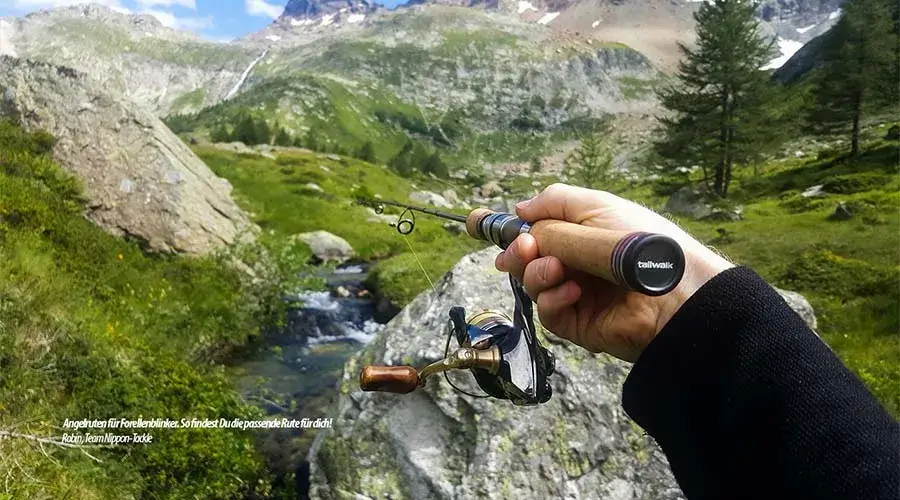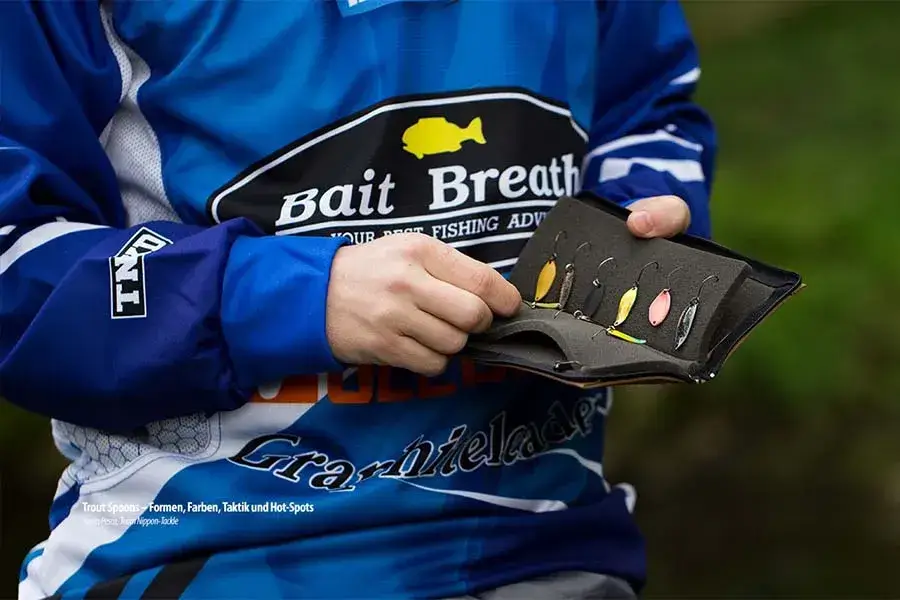Trout fishing
Whether by the sea, in a small mountain stream, in a large Alpine lake or in an artificial pond: trout have always been popular and are becoming increasingly popular. Reason enough to give salmonids, especially Atlantic trout (brown trout, lake trout, sea trout) their own target fish section.

You need different rods, reels, line and bait depending on the water and situation. Brown trout have different feeding habits in a small mountain stream than in a shallow, wide river or a clear lake. First of all, it is important to find out whether the fish are hunting other fish or whether they prefer insects. Accordingly, we need to use bait that best imitates this prey in terms of both shape and color. The next step is to take a look at the structure of the water. Of course, not every spot on a lake or stream has the same structure, but on most bodies of water you can immediately see which structure is predominant. Strong or fast current, shallow or deep, obstacles or bathtub.
Rods for trout fishing
Classic Japanese trout rods are two-piece, almost 100% have a cork handle, which can be either split or continuous, and are between one and a half and just over two meters long. Trout rods mainly have a regular taper, rarely also a regular fast taper. Depending on the type of trout bait, the casting weight can be up to a maximum of four grams and upwards to around ten grams.
Since light trout spoons with a dead weight of rarely more than three grams, but also up to less than one gram as well as small trout wobblers or rubber lures with a few grams of weight are usually used for trout fishing, the well-known spinning rod has prevailed so far. Anyone who is often out and about on small flowing waters with overhanging branches and little room to maneuver will be familiar with the advantages of a handy spinning rod with a regular taper, as is common for trout rods from the JDM range. Such spinning rods only need a flick of the wrist and the bait flies to the targeted spot.

The aforementioned regular taper of a trout rod supports the cast by making the blank easier to load. Anyone who now thinks that you can't set a hook or control the wild escapes of a trout with a regular taper is mistaken. A sharp hook and a monofilament fishing line with little stretch counteract these fears. And anyone who has ever watched a fly fisherman during a fight will have noticed that feeling and calmness are much gentler on the fish - and therefore more accurate and on target at the same time - and also reduce drop-outs, meaning that the angler does not have to fight back unnecessarily. And all of this also works with barbless single hooks!
Trout bait - plugs & mini softbaits
Trout can be outwitted with almost all types of bait. Some are particularly promising in streams, others more so in lakes. In general, it can be said that salmonids, as cannibals, are particularly fond of decors with circles, i.e. trout decors. However, it is advantageous to use matt decors on heavily fished, clear waters. This is because the glitter effect can have more of a scaring effect here.
Hardbaits are lures made of plastic or wood. They are available in various designs. In addition to sinking (S) and floating (F) models, there are also floating, so-called 'suspenders' (SP). These maintain their depth during a spin stop. Many of our models are equipped with a weight system, which stabilizes the flight and thus ensures greater casting distances.
The two best-known hardbaits are minnows and crankbaits. Minnows are narrow, elongated plugs that are perfect for twitching. Crankbaits, on the other hand, are short and stocky and are used by most anglers as steady retrieves. Due to their spherical shape, they run very conspicuously and stimulate the predator's lateral line organ to a high degree. This model is also very suitable for searching a large area of water for active fish.
The term area wobbler is used in Japan to describe wobblers that have been specially developed for pond fishing. As the owners of commercial fishing facilities in Germany are increasingly prohibiting the use of treble hooks, almost all area hardbaits are equipped with single hooks.
Topwater plugs can be used to imitate hatchery fish and insects. Small stickbaits up to 5 cm are best suited for this. We can also go a little off the beaten track here with the choice of color. The only important thing is to create a nice contrast against the topwater world.
Basically, all softbaits that are also of interest to perch are suitable for trout fishing. Whether action shad, V- or pintail, on a jig head or on various rigs. Fishing with crayfish in streams is also interesting. Many of our watercourses are colonized by American crayfish and signal crayfish. Trout also appreciate the protein-rich food and only disdain a lifelike imitation when their stomach is full. It is therefore worth trying different finesse rigs in heavily fished waters to lure the wise old lady out of hiding.
Mini spoons aka spoons / trout spoons

“Back to the roots” is the motto for trout fishing in Japan. Classic materials such as wood or metal are not only used on the rods. Very small, lightweight spoons, which are specially made for this purpose, are used a lot. They come in many different shapes, from round to elongated to diamond-shaped. Each shape has different characteristics. They are perfect for imitating small fry or insects and can also be used to trick shy trout, which have already seen all the usual lures, into biting. Equipped with a barbless (BL) single hook, they come to us very gently from Japan. Undersized fish can be released without any problems.